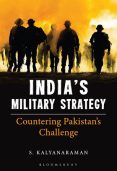Military Diplomacy Through Arms Transfers: A Case Study of China
Military diplomacy has long been one of the essential constituents of international diplomacy and an effective method to foster bilateral and regional relationships. Arms transfers serve as an important foreign policy tool and have become, a crucial dimension of world politics. Conventional arms transfers entail not only the provision of weapons/ equipment but carry with them a number of military commitments that have long?term implications. The PLA has always had a significant role in shaping and implementing China's foreign policy.
- B. S. Sachar
- April 2004








